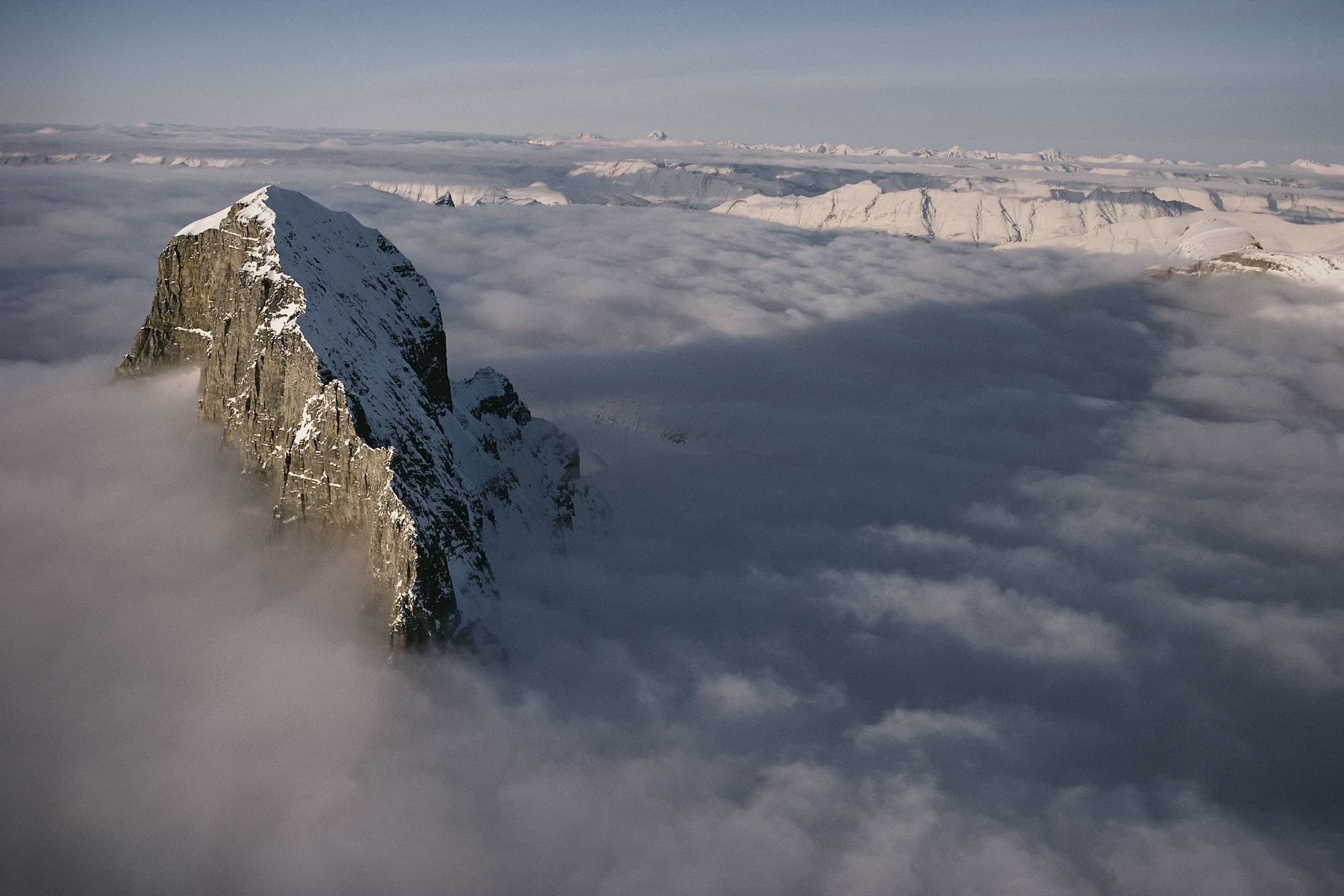What do clouds do to the daytime temperature
Cloud Cover
Deject Cover
Cloud comprehend is an important component of agreement and predicting the atmospheric condition. Not just does cloud cover impact sky conditions and inform precipitation predictions, it likewise helps regulate the temperature that occurs in a region.
Subjects
Earth Science, Meteorology
Image
Through the Clouds
The meridian of Mountain Alberta in Jasper National Park in Alberta, Canada, peaks upward through a thick layer of cloud cover.
Photograph past Dean Conger / National Geographic

Clouds grade throughout all the levels of the temper and affect both weather and climate. The type and amount of clouds that commonly form over a region bear on the atmospheric precipitation atmospheric condition. Cloud encompass may also influence temperatures at the surface of the planet. Water evaporates from the ground and condenses in the atmosphere, resulting in a wide variety of cloud shapes: from large, puffy clouds to wispy formations. When at that place are few clouds in a region, it mostly signals the presence of a high-pressure level system, which ways that residents can expect fair conditions and no atmospheric precipitation. Certain clouds, such as low-level, curt, cumulus clouds, betoken that fair conditions is moving into the expanse. Residents can expect sunny skies and little precipitation. When high-level cirrus or low-level stratus clouds increment in a region, the region can await to run into precipitation from an incoming low-pressure system. Cirrus clouds are thin, wispy clouds that normally occur in the upper levels of the atmosphere alee of a storm. Stratus clouds are thin-layered, gray clouds that can consequence in light atmospheric precipitation. Virtually clouds have on these three basic shapes—cumulus, cirrus, and stratus—and are further classified as nimbo-grade if they bring rain. For case, thick, greyness, stratus clouds that bring heavy atmospheric precipitation are chosen nimbostratus. However, clouds do more than bring rain or off-white atmospheric condition. Clouds likewise human action as an "atmospheric coating" that helps to regulate the temperature at Earth'south surface. During the day, clouds reflect a portion of the solar energy that reaches Earth back into space. This prevents the planet from condign as well warm. Clouds tin also act like a blanket, trapping heat on World by absorbing the heat released by the surface of the planet. They radiate this heat back toward Earth, warming the lower regions of the atmosphere. Whether clouds heat or cool the surface of Earth depends on the peak and type of deject present in the sky. Loftier-level, feathery clouds help heat the planet during the day, assuasive sunlight to penetrate the surface and prevent heat from escaping. Meanwhile, lower level clouds frequently reflect heat from the sun back into space and proceed the surface temperatures absurd. Deject cover tin can too limit the cooling that occurs in a region at night. Typically, the solar heat captivated by the ground during the day is released at night as Earth cools. The warm air near the ground rises in a process known as radiative cooling. However, if thick cloud cover is present over a region where such radiative cooling is happening, some of the heat is trapped and reflected back to Earth by the clouds. This keeps the surface warmer than it would exist during a night without cloud cover.

The summit of Mount Alberta in Jasper National Park in Alberta, Canada, peaks up through a thick layer of cloud cover.
Photo by Dean Conger / National Geographic
cirrus
Noun
thin, loftier-altitude deject.
Noun
visible mass of tiny water droplets or ice crystals in Earth's atmosphere.
Noun
amount of sky covered with clouds.
cumulus
Substantive
type of large deject with a flat bottom and fluffy tops.
high-pressure system
Noun
conditions pattern characterized by high air pressure, unremarkably as a result of cooling. High-pressure systems are usually associated with clear weather.
low-pressure system
Substantive
weather pattern characterized by low air pressure level, usually as a result of warming. Depression-pressure systems are often associated with storms.
Noun
all forms in which water falls to World from the atmosphere.
Noun
liquid precipitation.
snowfall
Substantive
precipitation made of ice crystals.
stratus
Substantive
mid-level clouds establish up to an elevation of nearly 2000 meters above the Earth.
Noun
caste of hotness or coldness measured past a thermometer with a numerical scale.
scovilletwood1954.blogspot.com
Source: https://www.nationalgeographic.org/encyclopedia/cloud-cover/#:~:text=High%2Dlevel%2C%20feathery%20clouds%20help,keep%20the%20surface%20temperatures%20cool.
0 Response to "What do clouds do to the daytime temperature"
Post a Comment